
The Democratic Republic of the Congo (DRC) is almost the size of Western Europe. It is potentially one of the richest countries in Africa. For a long time, its mineral resources were a source of war, corruption and plunder, but since the peace treaty of 2003 and the first free elections (2006), the road to prosperity seems to have been laid.
Timeline
1881 Trading post
British explorer Henry Morton Stanley founds a trading post at Leopoldville, later Kinshasa.
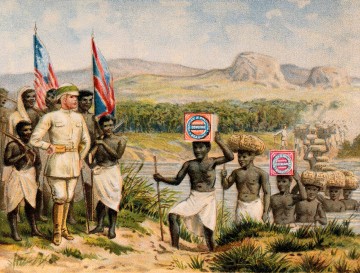
Popperfoto/Getty Images
1885 King Leopold II
Congo becomes the personal property of Belgian king Leopold II. And at the exact time the pneumatic car tire is invented, rubber is discovered in the Congo – resulting in a fortune for Leopold II. Approximately five million Congolese die from exploitation and disease.
1908 Belgian colony
Following international protests about the human rights situation, the Belgian parliament gives in and takes the colony from the king. The country is now known as Belgian Congo. The administration improves, but inequality remains the same.
1945 – 1955 A new era
More and more Congolese move to the city. Men who were previously farmers or smiths go to work in the factories. In twenty years, the population of Kinshasa doubles, to 50 thousand. A new black, urban elite arises.
1960 Independence
Continuing inequality and the patronizing attitude of the Belgians towards the native population leads to unrest. Fearful of a war of independence such as in Algeria, the Belgians withdraw.
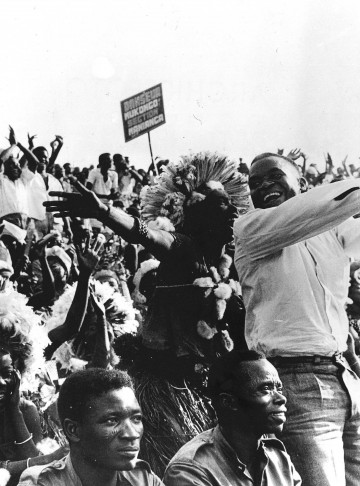
4 July 1960, independence celebrations, Baudouin Stadium, Kinshasa.
1965 Mobutu
Five years after independence, Congo is in a state of chaos and instability. Colonel Mobutu stages a coup d’état and sets up a one-party state, of which appoints himself head. He dreams of a new Congolese nationalism and gives the country, every provincial capital and every citizen a new name. The new post-colonial elite enjoy the legacy of Belgian rule.
1975 – 1997 Decline
The first ten years of the Mobutu era are golden years, but then decline sets in. Mobutu enriches himself at the expense of the country and its people. The infrastructure is pitiful, people are dying of hunger and civil servants are hardly ever paid. In 1984, Mobutu’s personal fortune is estimated at 4 million dollars – equal to the country’s national debt.
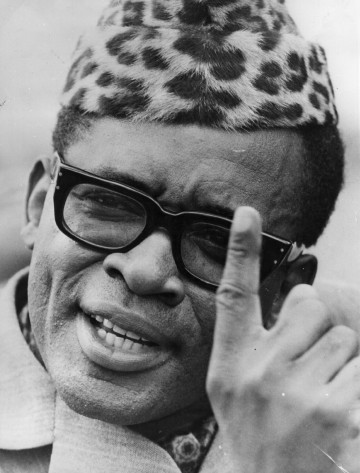
19 May 1978, Mobutu Sese Seko bans Western clothing: men are obliged to wear the ‘abacost’, a Mao-like suit. Women must wear the traditional pagne: a dress, blouse and headscarf.
1996 War
As a result of the Rwandan genocide (1994), Hutus flee to Zaire. The refugee camps fall under the control of Hutu militia, prompting the predominately Tutsi Rwandan army to invade Zaire, supported by troops from Burundi and Uganda. This marked the start of the Congolese war, the biggest war in the world (after World War II). 3.8 million people lost their lives, and millions fled.
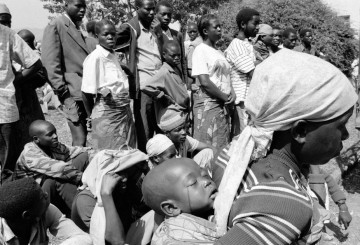
July 1994, Rwandan refugees waiting for help in refugee camps in Goma, eastern Congo.
1996 Congo again
Tutsi rebels and anti-Mobutu troops push out of eastern Congo, towards Kinshasa. Mobutu flees and rebel leader Laurent-Désiré Kabila becomes president. Zaire is renamed: the Democratic Republic of the Congo.
1999 Peace mission
The official government has completely lost control of the country. There is no independent judiciary and no functioning security service. The UN sends in troops to protect the citizens. With 25 thousand men, Monuc is the biggest and most expensive peace mission ever (costing a billion dollars a year). Aid organisations criticise the mission because the UN troops are unable to protect the citizens and prevent the mass rape of women and children.
2001 Joseph Kabila
Kabila is murdered by his bodyguards. A unanimous vote in parliament appoints his son, Joseph Kabila, as his successor.
2003 False peace
Officially, there is peace – but eastern Congo remains unstable. All pretence that this is about ideals has long been given up. What counts is getting control of the natural resources. It is estimated that some fifty rebel groups are fighting for power in the lucrative areas, using the profits to finance their struggle.
2006 Green shoots of democracy
Joseph Kabila becomes the first democratically elected President of Congo since independence. He announces les cinq chantiers: a kind of Marshall Plan for the reconstruction of the country.
2009 The China-Congo contract
There is precious little money for reconstruction after all these years of war. So an exceptional barter agreement is entered into with China. Congo supplies ten million tonnes of copper and six hundred thousand tonnes of cobalt in return for six billion Euros’ worth of infrastructure projects. In Kinshasa, streetlights are lit along the asphalted Boulevard du 30 Juin, and the sewerage system is renewed, among other projects.
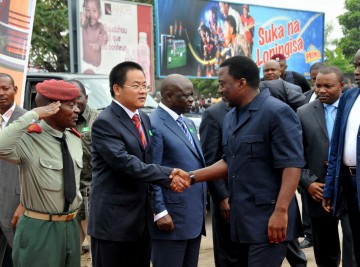
13 March 2010, President Joseph Kabila and the Chinese representative of Guangdong Changda Highway Engineering Corporation at the opening ceremony for a new road between Lumumba Street and the Presidential Office.
2010 Growth
The country’s mineral resources have been the cause of so much plunder and conflict, but since the peace treaty and the first free elections, the road to prosperity seems to have been laid. From 2010, the DRC is one of the fastest growing economies in Africa. The mining industry, improved agricultural production and large infrastructure projects in particular are powering growth.
2012 New rebels
M23, a rebel group fighting for rights for Tutsis, is set up and violence flares again when they take the city of Goma. In November 2013, the government signs a peace treaty in Kampala, Uganda. Leaders and rebels flee to Rwanda.
2014 Megacity
With an estimated ten million inhabitants, Kinshasa officially becomes the third African megacity, after Lagos and Cairo. Rapid urbanisation and the enormous concentration of people bring problems: half of the inhabitants have no access to safe drinking water; only one third have reasonable sanitation. But there are also opportunities: the average Kinois earns two-and-a-half times as much as other Congolese.
2016 Presidential elections
President Kabila’s second term comes to an end. A significant moment in this frail democracy; will he relinquish power?
2025 Hotspot for growth
Kinshasa has an estimated 14.5 million inhabitants. This population is one of the youngest in the world, making the city one of the biggest growth markets in the world, according to the McKinsey Global Institute. In a report on Global Cities of the Future, Kinshasa is in the top twenty hotspots for growth in 2025.